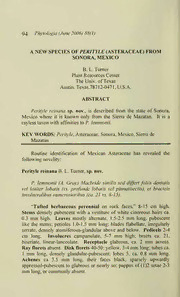
A new species of Perityle (Asteraceae) from Sonora, Mexico PDF
Preview A new species of Perityle (Asteraceae) from Sonora, Mexico
94 Phytologia (June2006) 88(1) A NEW SPECIES OFPERITYLE(ASTERACEAE) FROM SONORA, MEXICO B. L. Turner Plant Resources Center The Univ. ofTexas Austin, Texas,78712-0471, U.S.A. ABSTRACT Perity-le reinana sp. nov., is described from the state of Sonora, Mexico where it is known only from the Sierra de Mazatan. It is a raylesstaxonwith affinities to P. lemnionii. KEY WORDS: Perityle, Asteraceae, Sonora, Mexico, Sierra de Mazatan Routine identification of Mexican Asteraceae has revealed the followingnovelity: Perityle reinana B. L. Turner, sp. nov. P. lemnionii (A. Gray) Macbride similis sed differtfoliis dentatis vel leniter lobatis (vs. profunde lobatis vel pinnatisectis), et bracteis involucralibiis numerosioribus (ca. 21 vs. 8-15). 'Tufted herbaceous perennial on rock faces," 8-15 cm high. Stems densely pubescent with a vestiture ofwhite cinereous hairs ca. mm mm 0.3 high. Leaves mostly alternate, 1.5-2.5 long, pubescent mm like the stems; petioles 1.0-1.5 long; blades flabellate, irregularly serrate, densely atomiferous-glandular above and below. Pedicels 2-4 cm long. Involucres campanulate, 5-7 mm high; bracts ca. 21, mm biseriate, linear-lanceolate. Receptacle glabrous, ca. 2 across. Ray florets absent. Disk florets 40-50; yellow, 3-4 mm long; tubes ca. mm mm 1 long, densely glandular-pubescent; lobes 5, ca. 0.8 long. Achenes ca 3.5 mm long, their faces black, sparsely upwardly appressed-pubescent to glabrous or nearly so; pappus of(1)2 setae 2-3 mm long, or commonly absent. Phytologia (June2006) 88(1) 95 TYPE: MEXICO. SONORA: Mpio. de Ures, Canada el Vugo, Sierra de Mazatan, oak woodland on granite, 1383 m, 29 Apr 2004, T. R. Van Devender et al. 2004-476 (with Reina, Sanchez E., Ferguson, Anderson & Johnson) (HolotypeTEX; isotype ARIZ ). ADDITIONAL SPECIMEN EXAMINED: (same Sierra as above) "Ca. 0.5 km below Aguage in Canada del Alamo," 13 Mar2005, Reina etal. 2005-196(ARIZ, TEX) Peritylereinana belongsto the section Laphamia and relates to the eligulate P. lemmonii, as noted in the diagnosis. It also might be confused with the occasional rayless form of P. genttyi, the latter distinguished by its longer petioles, more regular dentate leafmargins, and longer(pilose) vestiture. The following key to rayless members of Sect. Laphamia, this from my forthcoming treatment of Perityle for the Comps of Mexico (PhytologiaMemoirs, in prep.) will serveto distinguish thetaxon: 6. Leaves dentate or lacerately lobed, with4-8 teeth or lobes to a side (12) 6. Leaves entire, merely dentate, orprominently 3-lobed, with 1-3 lobesto a side (7) 7. Leaves irregularly dentateto laciniately lobed (9) 7. Leavesregularly dentate withmostly neat, acute teeth (8) 8. Involucres 3.5-4.5 mm high; ne Chi, nw Coa P. castillonii 8. Involucres 5-6 mm long; Son, w Chi P. gentry! 9 (7). Stems and leaves densely white-tomentose; Son P- vandevenderi 9. Stems and leavesgreen orgreenish, notwhite- tomentose (10) 10. Involucral bracts 8-12, linear-lanceolate, gradually tapering to a narrowly acute apex; ne Chi P- dissecta 96 Phytologia (June2006) 88(1) 10. Involucral bracts 12-21, linear-oblanceolate, ratherabruptly tapered to an acute orobtuseapex; nw Chi, Son (11) 1 1. Involucral bracts 12-15; leaves deeply lobed or dissected P. lemmonii 1 1. Involucral bracts ca. 21; leaves not dissected P. reinana 12(6). Leaves entire ormerely dentate; pappus absent P. angustifolia 12. Leaves manifestly 3-lobed; pappus present P. coahuilensis According to its principal collector, the Sierra de Mazatan is an isolated 'sky island" mountain range about 80 km east of Hermosillo. The lower slopes on three sides support foothills thorn-scrub, whilethe northwestern slopes support desert-scrub. On the top ofthe range, the vegetation is open oak woodland in a grassland matrix on relatively flat, gneiss bedrock surfaces. Tropical species extend up the canyons and are locally present in the oak woodland at 1350-1400 m elevation. The species is named for one of its collectors. Ana Lilia Reina. She received an undergraduate degree in Agricultural Sciences from the Univ. of Sonora in Hermosillo, and has been involved in ethnobotanical studies with the Seri and Mayo Indians. For the last nine years she has been working on floristic surveys in eastern Sonora and the Arizona-Sonora borderregion. ACKNOWLEDGMENTS I am grateful to my good friend and colleague Guy Nesom forthe Latin diagnosis and to Tom Van Devender for information relating to the geobotanical aspects ofthe Sierra de Mazatan.
